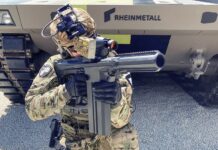Future Combat Systems went through a successful force development test and experiment (FDT&E) recently, in a field test at Fort Bliss. Army Evaluation Task Force Soldiers tested FCS Spin Out 1 systems over the course of several weeks within conditions representative of today’s operational environment in Iraq or Afghanistan.
Planning for the FDT&E began over two years ago and culminated in one of the largest user tests in Army history. Participants from across TRADOC and the 5th Brigade (Army Evaluation Task Force), 1st Armored Division deployed a company team consisting of two Bradley platoons, two Abrams platoons and a scout platoon supported by an various FCS ‘Spin-Out’ systems, including unattended sensors and Non Line Of Sight –Launch System (NLOS-LS) section, all controlled by the battalion headquarters. The unit performed attack, screen, defend, cordon and search, and force protection tasks against conventional and insurgent adversaries operating among a robust civilian population in both urban and desert terrain.
The FCS spin-Out systems participating in the test included the Non-Line of Sight Launch System (NLOS-LS), a box of rockets capable of delivering precision fires from great distances to lower-level tactical units, enhancing the lethality of the supported forces. Two sensor systems, the tactical unattended ground sensors, and the urban unattended ground sensors are designed to increase situational awareness and understanding across the force while minimizing soldier risk by providing pictures and sensor warnings to the force. The pictures and warning generated by the sensors were handled through the fourth system in Spin-Out 1 – the ‘early network hardware’. This hardware consists of a computer and pre-production joint tactical radio system, known as JTRS. Together these four systems are designed to enhance lethality and survivability of the modular brigade combat team by adding limited FCS capability to the force before the final version of FCS is available.
Capabilities of the systems will be placed in the hands of Soldiers and leaders at the platoon level and lower. Until now, most of the capabilities have been out of reach at that level and most often found at the battalion level and higher. Sensors will now be “networked” to the platoon level. This will provide situational awareness that contributes to more precise operations in environments where Soldiers must operate among people.
It was the first time FCS equipment has been tested in continuous operations under stressful, realistic conditions in the hands of soldiers. By any measure, officials said it was a huge success. Soldiers verified that the equipment performed to acceptable standards, and added operational value to their formation. Soldiers were able to validate that the equipment worked as designed, with the normal challenges one would expect in an early test, and, as Soldiers are prone to do, they also discovered new and different ways to employ the systems under combat conditions to provide the most value added.
The next test is planned for November 2008 will integrate land warrior systems directly linking dismounted leaders of small units into the network. This capability will increase connectivity and situational awareness of the entire force.












